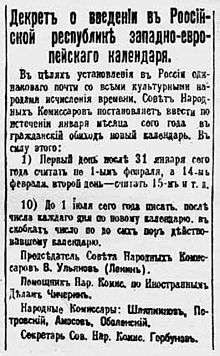Lenin's First and Second Government
Following the October Revolution, Vladimir Lenin became the head of the new government of the Russian Soviet Federative Socialist Republic. It was known officially as the Council of People's Commissars, effectively his cabinet.
| Lenin Government | |
|---|---|
12th Cabinet of Russia (as Russian SFSR) | |
%2C_1918.jpg) | |
| Date formed | November 8, 1917 |
| Date dissolved | January 21, 1924 |
| People and organisations | |
| Head of government | Vladimir Lenin |
| Member party | Communist |
| Status in legislature | Majority |
| History | |
| Incoming formation | Alexander Kerensky's Second Cabinet |
| Outgoing formation | Alexei Rykov's Cabinet |
| Predecessor | Alexander Kerensky |
| Successor | Alexei Rykov |

After Joseph Stalin had risen from commissar to become General Secretary of the Communist Party, in the 1930s he conducted a Great Purge to destroy his opposition, including ten of the fourteen members of this first council. His forces, including the NKVD, mounted operations against intellectuals and professionals, kulaks, ethnic minorities, and others, resulting in an estimated 980,000 to 1.2 million deaths throughout the USSR.[1]
Council of People's Commissars
The Council of People's Commissars of the RSFSR (Russian: Совет народных комиссаров РСФСР) was the governmental cabinet of the Russian Soviet Federative Socialist Republic (RSFSR) from 1917 through 1946. That year it was renamed the Council of Ministers of the RSFSR. Following the Declaration of the Creation of the USSR in 1922, state powers of this institution of the RSFSR were somewhat superseded by the Council of People's Commissars of the USSR.
By September 1917, the councils (soviets) of workers, peasants and soldiers acquired considerable political and military power. The leaders of the Petrograd Soviet conspired to overthrow the Russian Provisional Government; the uprising started on 7 November 1917, when Red Guards units captured the Winter Palace. On the next day, 8 November 1917, the Second All-Russian Congress of Soviets recognized the success of the uprising, and formally established the new government, reflecting the capture of the soviets by the Bolsheviks.
The government was formally called the Council of People's Commissars (Совет народных коммиссаров), abbreviated as Sovnarkom (Совнарком). Leon Trotsky devised the council and commissar names, thereby avoiding the more "bourgeois" terms of minister and cabinet.
The People's Commissars (Russian: Народный комиссар, translit.: Narodny komissar, or Narkom) functioned as government ministers. A ministry was called a People's Commissariat (Russian: Народный комиссариат, translit.: Narodny komissariat, abbreviated to narkomat).
Formation
%2C_1918.jpg)
Traditionally, the executive part of a government is directed by a council of ministers nominated by a ruler or by a president. The Bolsheviks considered this to be a bourgeois institution, and wanted to create what they believed was a new government made up of a 'soviet' of workers and peasants.
The role and structure of the Sovnarkom was formalized in the 1918 Constitution of the RSFSR. The Sovnarkom of the RSFSR was responsible to the Congress of Soviets for the "general administration of the affairs of the state". The constitution enabled the Sovnarkom to issue decrees carrying the full force of law when the Congress was not in session. The Congress routinely approved these decrees at its next session.
Each People's Commissar was head of commissariat and had several deputies and a colleguium, which functioned as a deliberative body to advise the commissar.
The Chairman of the Council of People's Commissars, also elected by the Congress, had a function similar to that of a prime minister. The first Chairman of the Sovnarkom was Vladimir Lenin.
First People's Commissars
The first council elected by the Second All-Russian congress was composed by the following 14 members. Eight of the men were executed and one died in prison during the late 1930s, the time of terrorism and the Great Purge by Joseph Stalin, then General Secretary of the Communist Party and leader of the USSR. Trotsky was assassinated in Mexico in 1940 as part of his destruction of opposition.
| People's Commissar | Original incumbent | Death |
|---|---|---|
| Chairman | Vladimir Lenin | Natural causes 1924 |
| Executive Officer | Nikolai Gorbunov | Executed 1938 |
| People's Commissariat for Agriculture of the RSFSR | Vladimir Milyutin | Died in prison 1937[2] |
| People's Commissariat for Military Affairs of the RSFSR | Vladimir Antonov-Ovseyenko | Executed 1938 or 1939 |
| People's Commissariat for Naval Affairs of the RSFSR | Pavel Dybenko | Executed 1938 |
| People's Commissariat for Trade and Industry of the RSFSR | Viktor Nogin | Natural causes 1924 |
| People's Commissariat for Education of the RSFSR | Anatoly Lunacharsky | Natural causes 1933 |
| People's Commissariat for Food | Ivan Teodorovich | Executed 1937 |
| People's Commissariat for Foreign Affairs of the RSFSR | Leon Trotsky | Assassinated 1940 |
| People's Commissariat for Interior Affairs of the RSFSR | Alexei Rykov | Executed 1938 |
| People's Commissariat for Justice of the RSFSR | Georgy Oppokov | Executed 1938 |
| People's Commissariat for Labour of the RSFSR | Alexander Shlyapnikov | Executed 1937 |
| People's Commissariat of Nationalities | Joseph Stalin | Natural causes 1953 |
| People's Commissariat for Posts and Telegraphs of the RSFSR | Nikolai Glebov-Avilov | Executed 1937 |
| People's Commissariat for Railways of the RSFSR | (vacant) | |
| People's Commissariat for Finance | Ivan Skvortsov-Stepanov | Natural causes 1928 |
References
- Ellman, Michael (2002). "Soviet Repression Statistics: Some Comments" (PDF). Europe-Asia Studies. 54 (7): 1151–1172. doi:10.1080/0966813022000017177.
The best estimate that can currently be made of the number of repression deaths in 1937–38 is the range 950,000–1.2 million, i.e . about a million. This is the estimate which should be used by historians, teachers and journalists concerned with twentieth century Russian—and world—history
- D.B. Riazonov by Boris Souvarine, accessed 3 December 2008